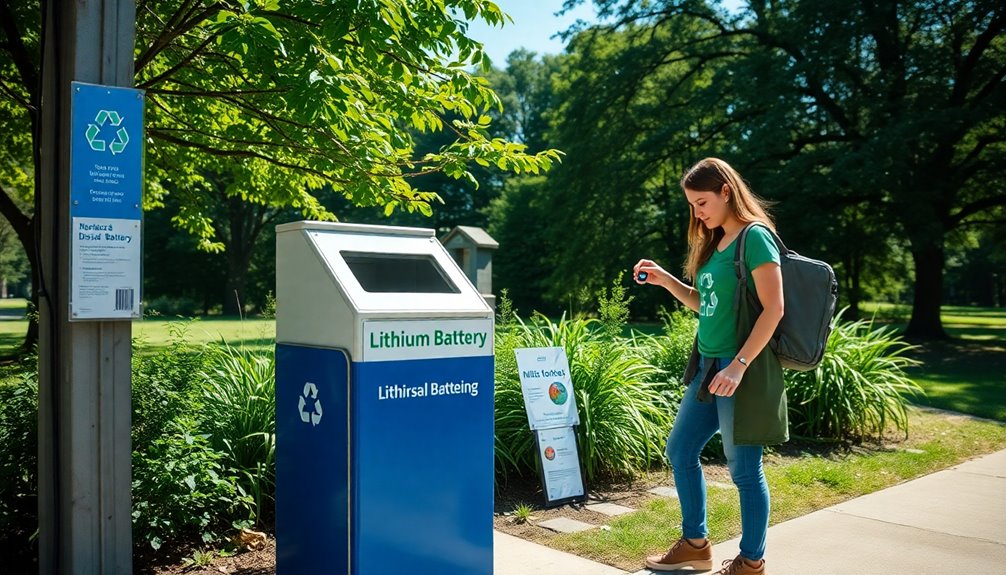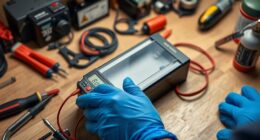Rechargeable batteries work by storing energy through reversible chemical reactions. When you charge a battery, electrons flow back to the anode, restoring its original state. During discharge, oxidation at the anode releases electrons that travel to the cathode, powering your devices. Different types, like lithium-ion and lead-acid, have unique features suited for various applications. Their efficiency depends on factors like temperature and charging speed. Innovations are constantly improving battery technology, making them safer and more efficient. If you're curious about the future developments and benefits of these advancements, there's plenty more to explore.
Key Takeaways
- Rechargeable batteries store energy through electrochemical reactions, involving oxidation at the anode and reduction at the cathode during discharge and charge cycles.
- During discharge, electrons flow from the anode to the cathode, converting chemical energy into electrical energy to power devices.
- Charging reverses the reactions, with external current driving electrons back to the anode, restoring original material states.
- Common types include lithium-ion, nickel-cadmium, and lead-acid, each with unique characteristics and applications in various fields.
- Innovations like solid-state batteries and fast charging techniques are enhancing performance, safety, and sustainability in battery technology.
Overview of Rechargeable Batteries
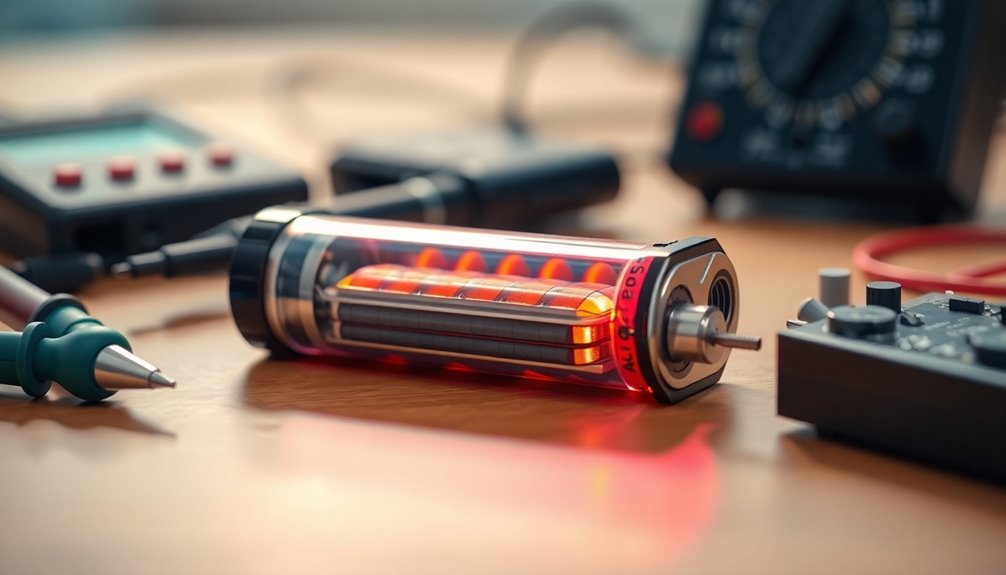
Rechargeable batteries, often called secondary cells, offer a sustainable energy solution because they can be reused multiple times through reversible electrochemical reactions.
These batteries, like lithium-ion, nickel-cadmium, and lead-acid, store chemical energy that's transformed back into electrical energy during discharge. The charging process forces electrons back to the anode, allowing you to power your devices repeatedly.
With a typical cycle life ranging from 500 to 1,000 charges, rechargeable batteries considerably outlast single-use alternatives. However, factors such as temperature and charging practices can impact their lifespan and efficiency.
Chemistry Behind Energy Storage

When you use a rechargeable battery, it's all about redox reactions that enable energy storage and release.
The electrolyte plays an essential role here, acting as a conductor that helps ions move between the anode and cathode.
Understanding these processes will give you a clearer picture of how your devices stay powered.
Redox Reactions Explained
Understanding redox reactions is essential for grasping how batteries store and release energy.
In rechargeable batteries, oxidation occurs at the anode, while reduction takes place at the cathode. During discharge, chemical reactions convert stored chemical energy into electrical energy, with electrons flowing from the anode to the cathode through an external circuit.
When charging, you reverse these reactions, sending electrons back to the anode and restoring the original state of the materials.
- Redox reactions drive the energy conversion process.
- The anode and cathode play vital roles in energy flow.
- Proper chemical reactions enhance battery performance and cycle life.
Electrolyte's Role in Batteries
The electrolyte serves as an important component in battery chemistry, acting as a bridge for ion movement between the anode and cathode. It functions as an ionic conductor, enabling the flow of ions during charging and discharging.
In lithium-ion batteries, lithium salt solutions dissolved in organic solvents serve as the electrolyte. This medium allows for reversible redox reactions; during discharge, oxidation occurs at the anode while reduction takes place at the cathode, generating electrical energy.
The electrolyte's composition greatly impacts a battery's performance, as it directly affects ion mobility and conductivity. If the electrolyte degrades or gets contaminated, internal resistance increases, leading to reduced capacity over time.
Therefore, the electrolyte's health is vital for optimal battery function.
Charging Process Explained
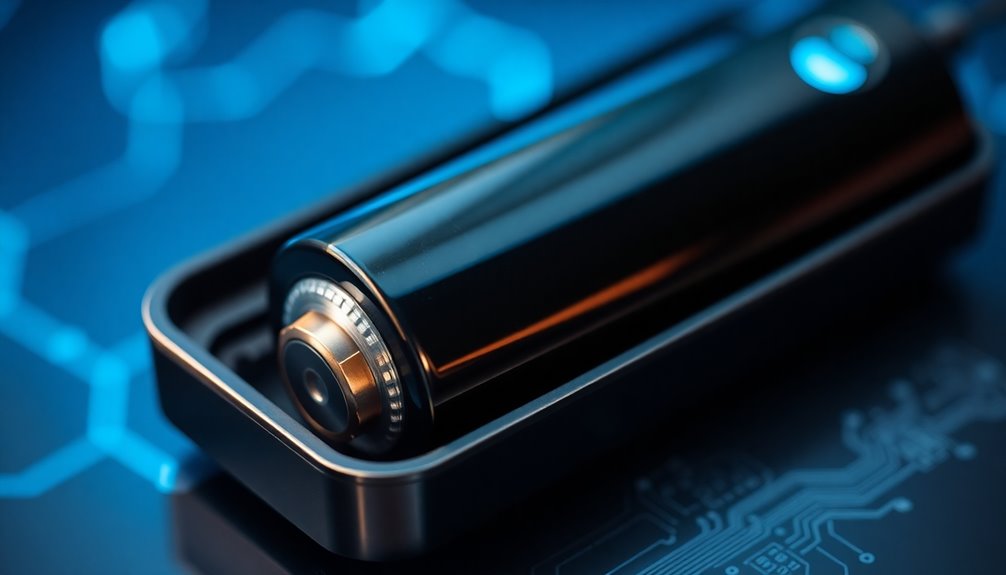
As you connect a rechargeable battery to a charger, an external electric current flows into the battery, driving electrons back to the anode and reversing the discharge reactions.
During this charging process, oxidation occurs at the anode, where compounds bond with incoming electrons, while reduction takes place at the cathode, consuming those electrons.
Charging times can vary widely, influenced by battery type and design, ranging from over 14 hours for slow charging to just 2 to 5 hours for rapid charging.
- The C rate helps determine safe charging speeds.
- Protection mechanisms prevent overcharging, avoiding safety hazards.
- Proper charging is essential for maintaining battery lifespan.
These elements work together to guarantee efficient and safe battery recharging.
Discharging Mechanism
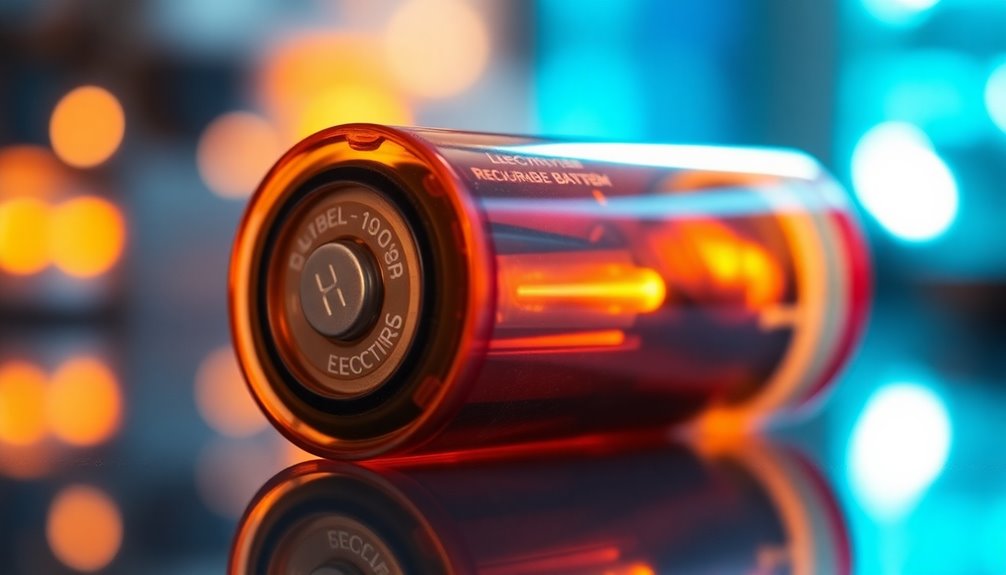
Once your rechargeable battery is fully charged, it's ready to discharge and power your devices.
The discharging mechanism in lithium-ion batteries involves a fascinating process where oxidation happens at the anode, releasing electrons. Meanwhile, reduction occurs at the cathode, consuming those electrons to generate electrical energy.
As lithium ions move from the anode to the cathode through the electrolyte, they facilitate the flow of electrons in the external circuit. This process operates like a galvanic cell, converting stored chemical energy into usable electrical energy.
Typically, the discharge voltage ranges from 3.0V to 4.2V, depending on the battery's chemistry. As the active materials at the electrodes diminish, you'll notice a gradual reduction in voltage until reaching the cutoff threshold.
Factors Influencing Battery Life

Several factors influence the lifespan of rechargeable batteries, and understanding these can help you maximize their performance.
Temperature plays a significant role; colder conditions typically enhance battery life by reducing self-discharge rates. Charge cycles are also vital; fewer cycles and shallower discharges lead to longer lifespan, while deeper discharges accelerate degradation.
To maintain your batteries effectively, consider these tips:
- Avoid overcharging to protect lifespan, as modern systems often have built-in mechanisms.
- Use high-quality materials for better performance and durability.
- Practice proper storage and regular maintenance to enhance overall battery life.
Key Battery Components
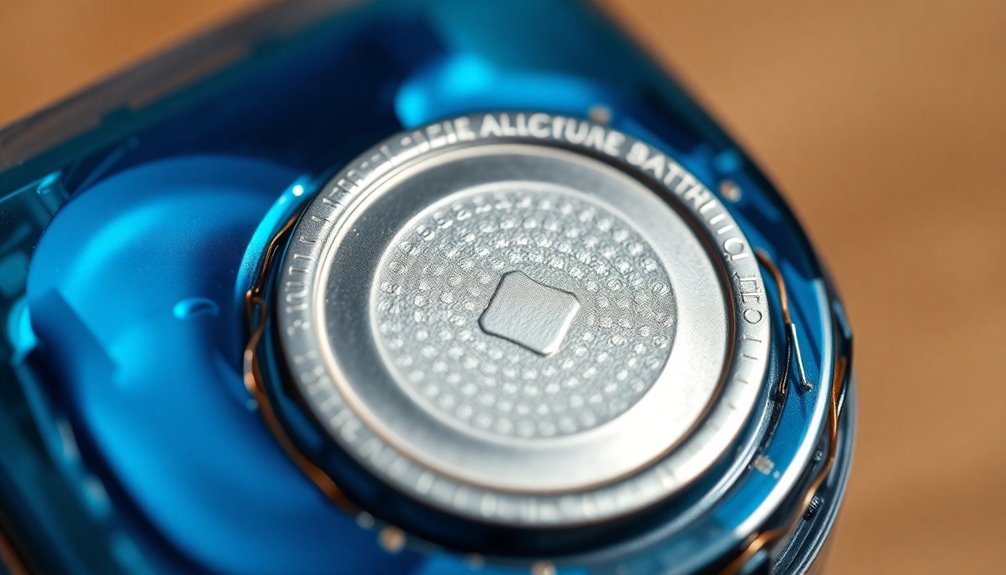
Understanding the key components of rechargeable batteries is essential for grasping how they function. At the heart of these batteries are two electrodes: the anode (negative) and the cathode (positive).
During charging and discharging, reversible chemical reactions occur at these electrodes, facilitating energy storage and release. The electrolyte, often a liquid or gel, enables ion movement between the anode and cathode, acting as an ionic conductor.
In lithium-ion batteries, the cathode usually consists of nickel, manganese, or cobalt oxides, while the anode is primarily graphite, allowing efficient lithium ion movement.
Additionally, a separator is vital; it prevents direct contact between the electrodes, avoiding short circuits while still allowing ion flow through the electrolyte.
Types of Rechargeable Batteries
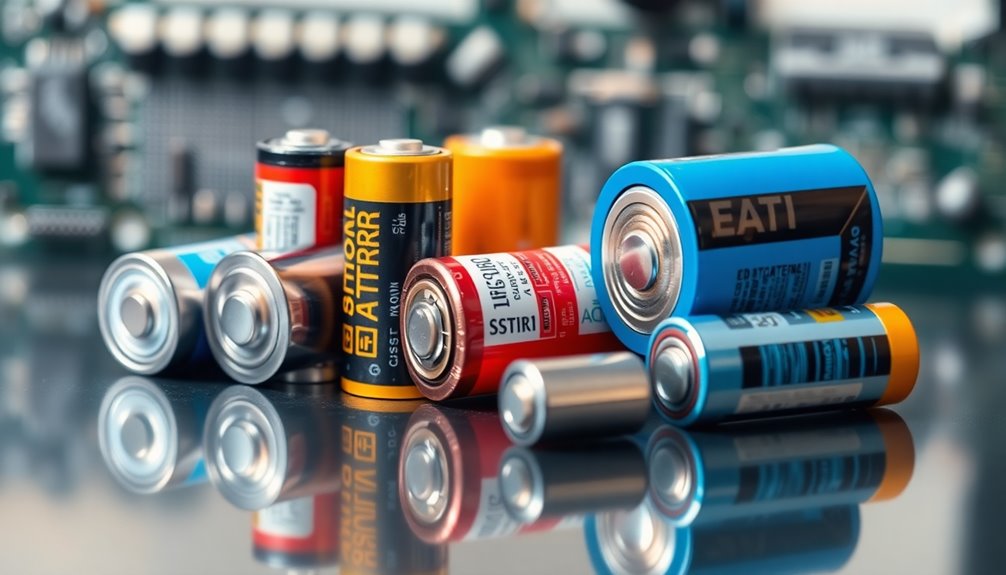
When it comes to rechargeable batteries, you've got several common types to evaluate, each with its own advantages and disadvantages.
From lead-acid to lithium-ion, knowing their strengths and weaknesses can help you choose the right one for your needs.
Plus, emerging technologies like nickel-zinc and sodium-ion are on the horizon, promising even more options.
Common Battery Types
There are a variety of rechargeable batteries available today, each with unique characteristics that make them suitable for different applications.
- Lithium-ion batteries: Known for high energy density, they're ideal for consumer electronics and electric vehicles.
- Nickel-cadmium batteries: Developed in 1899, they perform well in low temperatures but can suffer from a memory effect, reducing capacity over time.
- Lead-acid batteries: Commonly used in automotive applications, they're cost-effective and provide high voltage output, though they're heavy and have a limited shelf life.
All these rechargeable batteries utilize reversible electrochemical reactions to store and release energy multiple times, showcasing their versatility in various fields and settings.
Emerging technologies like nickel-zinc and lithium iron phosphate also offer exciting alternatives.
Advantages and Disadvantages
While rechargeable batteries offer significant advantages, they also come with some drawbacks that vary by type.
For instance, lithium-ion batteries are popular due to their high energy density and efficiency, powering everything from smartphones to electric vehicles. However, they require careful management to avoid overheating.
Nickel-Cadmium (NiCd) batteries excel in low temperatures and have a long shelf life, yet they usually come at a higher cost and have lower energy capacity.
Lead-acid batteries are low-cost and suitable for automotive use but are heavy and struggle in cold weather.
Finally, nickel-zinc batteries provide high voltage and longevity but lack available sealed forms, hindering wider adoption.
Each type has its unique advantages and disadvantages that you should consider.
Emerging Technologies Overview
As the demand for more sustainable energy solutions grows, innovative rechargeable battery technologies are emerging to meet this need.
You'll find several promising alternatives that enhance energy storage options:
- Sodium-ion batteries: A cost-effective choice for large-scale applications, using abundant sodium ions.
- Potassium-ion batteries: Research shows they could match lithium-ion energy density while being more sustainable.
- Zinc-bromine flow batteries: Ideal for grid storage, they offer scalability and a long cycle life.
Other technologies like vanadium redox flow batteries and molten-salt batteries also play significant roles.
The former allows power and energy scaling, while the latter operates at high temperatures, making them suitable for renewable energy integration.
These advancements are essential for a greener future!
Lead-Acid Battery Features

Lead-acid batteries stand out for their robust energy storage capabilities, making them a popular choice in automobiles. They consist of a positive electrode made of lead dioxide (PbO2), a negative electrode of sponge lead (Pb), and sulfuric acid as the electrolyte. While they offer significant storage capacity at a discharging potential of 2.02V, they're heavy and struggle in low temperatures. The charging process requires reversing the chemical reactions that occur during discharge, needing an external voltage of -2.02V. Despite their low cost, lead-acid batteries have a limited shelf life, making regular maintenance essential. Here's a quick overview of their features:
| Feature | Description | Importance |
|---|---|---|
| Positive Electrode | Lead dioxide (PbO2) | Generates voltage |
| Negative Electrode | Sponge lead (Pb) | Completes the circuit |
| Electrolyte | Sulfuric acid | Facilitates chemical reactions |
| Charging Process | Requires -2.02V | Reverses discharge reactions |
| Limitations | Heavy, poor performance in cold | Affects application efficiency |
Innovations in Battery Technology

You're about to discover some exciting innovations in battery technology that could change how we power our devices.
Solid-state batteries are leading the charge with their impressive energy density and safety features, while fast charging techniques promise to cut down on waiting times.
Plus, advancements in recycling methods are making it easier to reclaim valuable materials, supporting a more sustainable future.
Solid-State Battery Advancements
While the evolution of battery technology continues to accelerate, solid-state batteries stand out for their potential to transform energy storage. By using a solid electrolyte instead of a liquid one, these batteries enhance safety and considerably reduce leakage risks.
With an impressive energy density, they can offer up to 50% more energy storage than current lithium-ion batteries, leading to longer-lasting power for devices and electric vehicles.
Key advancements include:
- Improved ionic conductivity through new materials like sulfide and oxide electrolytes.
- A lifespan exceeding 1,000 charge-discharge cycles without major degradation.
- Major investments in research, predicting commercial viability by 2030.
These innovations could revolutionize the electric vehicle market, making solid-state batteries a game changer in energy storage.
Fast Charging Techniques
As battery technology advances, fast charging techniques are becoming essential for meeting the demands of modern devices and electric vehicles.
These methods utilize higher voltage and current to considerably reduce charging time, allowing batteries to reach 80% capacity in just 30 minutes.
Innovations like dynamic charging adjust charging rates based on battery temperature and state of charge, helping prevent overheating and extend battery lifespan.
Research into new materials, such as silicon anodes, shows promise for increasing charging speeds while maintaining battery capacity.
Advanced algorithms in fast chargers optimize the charging process by continuously monitoring battery health, enabling safe rapid charging.
Solid-state battery technology, expected by 2030, will offer even faster charging capabilities and improved safety compared to traditional lithium-ion batteries.
Recycling Innovations
With the rise in fast charging technologies, the focus on battery sustainability has never been more pressing. Innovations in battery recycling aim to recover nearly 100% of materials from spent lithium-ion batteries, greatly reducing environmental impact.
By developing new processes to recycle lithium, cobalt, and nickel, manufacturers can lower production costs and enhance sustainability.
Key advancements include:
- Advanced hydrometallurgical and pyrometallurgical methods that improve material recovery efficiency.
- Research into closed-loop systems that reintroduce recovered materials into production.
- Growth in the electric vehicle market driving demand for efficient recycling solutions.
These innovations not only promote a circular economy but also position the recycling sector to potentially reach $22 billion by 2030.
Future Trends in Battery Development
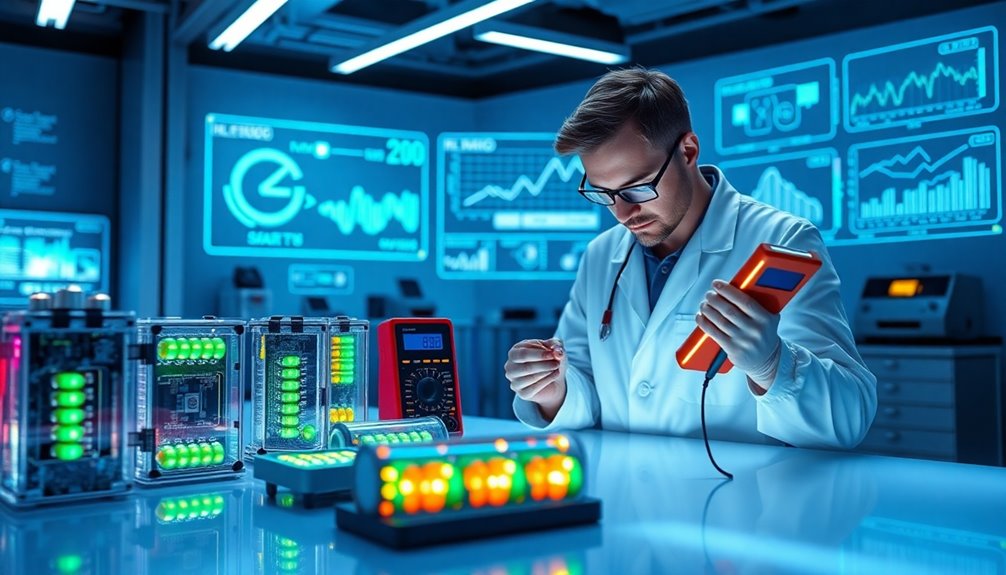
The future of battery development promises exciting advancements that could revolutionize energy storage and usage. Solid-state batteries are on the horizon, offering higher energy densities and enhanced safety by replacing liquid electrolytes with solid materials.
As demand for lithium-ion batteries continues to grow, especially in electric vehicles, the market is projected to expand considerably. Innovations in recycling processes aim for near 100% efficiency, reducing environmental impact.
Researchers are also exploring alternative chemistries like lithium-sulfur and sodium-ion batteries, which could provide lower costs and higher energy densities than traditional lithium-ion options.
Regulatory measures are pushing manufacturers toward safer, more environmentally friendly technologies, ensuring a sustainable future in battery development.
Frequently Asked Questions
How Do Rechargeable Batteries Work for Kids?
Rechargeable batteries work by storing energy through chemical reactions. When you use them, they release energy to power your devices.
Then, when you plug them in, electricity flows back into the battery, reversing the process and restoring their energy. You can recharge them hundreds of times!
Different types, like lithium-ion, are made for things like smartphones or toys.
Taking care of your batteries will help them last longer and work better.
What Is a Simple Definition of Rechargeable Battery?
A rechargeable battery is a type of battery that you can use multiple times. Instead of throwing it away after one use, you can charge it up again and again.
These batteries store energy through chemical reactions, allowing you to power devices like your phone or laptop. Plus, they're more environmentally friendly since they reduce waste and save you money in the long run.
How Does a Built in Rechargeable Battery Work?
Imagine a tiny power plant right inside your device! When you charge a built-in rechargeable battery, lithium ions rush from the cathode to the anode, like enthusiastic workers storing energy for later.
Electrons zip through the circuit, keeping everything balanced. When you use your device, those ions race back, releasing energy and powering your gadgets.
With protective circuits, these batteries can handle countless charges, making them a reliable, eco-friendly choice for your tech!
How Do Lithium-Ion Batteries Work for Dummies?
Lithium-ion batteries work by allowing lithium ions to move between two electrodes: a cathode and an anode.
When you charge your device, these ions travel from the cathode to the anode through an electrolyte, while electrons flow through an external circuit, creating electrical energy.
This process can happen hundreds or thousands of times, making them efficient and long-lasting.
Safety features are also built in to prevent overheating and guarantee safe usage.
Conclusion
To sum up, understanding rechargeable batteries not only helps you appreciate their role in your daily life, but it also highlights their environmental impact. Did you know that over 3 billion rechargeable batteries are sold annually? That's a staggering number, emphasizing our reliance on these power sources. By choosing rechargeable options, you're contributing to a reduction in waste and promoting sustainability. So, next time you recharge, remember you're making a difference for both yourself and the planet!


